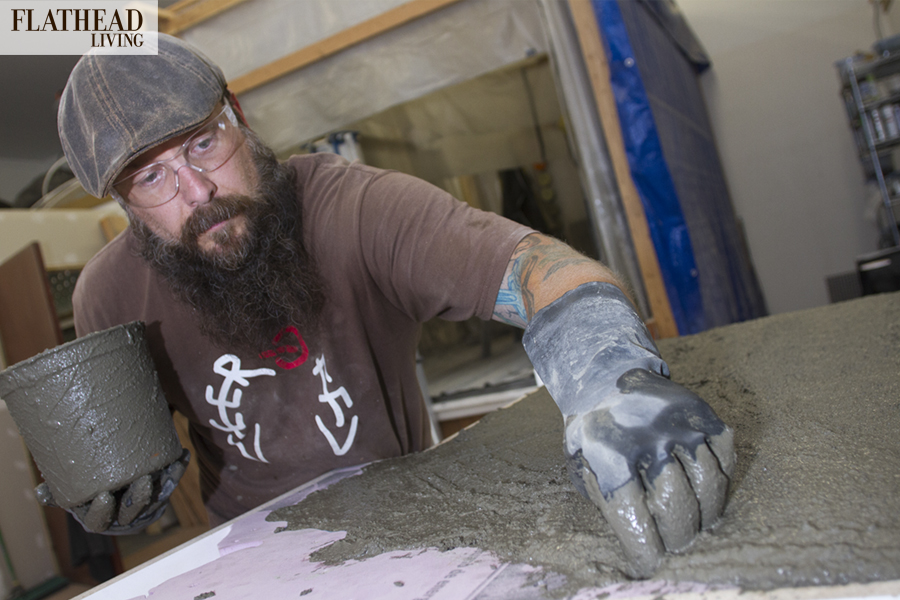On a summer day in 1995, during a break from laying concrete for the foundation of a Whitefish home, Trevor Osburn absentmindedly picked up a piece of rebar tie wire and wrapped it around a loose anchor bolt to create a spring. When the concrete truck pulled up and the team began to scree the poured-out concrete — that is, smooth it and scrape away the excess — he tossed the contraption away without a second thought.
A couple of days later, after the concrete had set and dried, Osburn returned to the site to clean it up. A particular piece of concrete that seemed to have something embedded in it caught his eye.
“It looked like a serpentine fossil,” Osburn says from his Kalispell workshop some 22 years later. “Like a fossil captured from an industrial era.”
It was the spring. Partially buried in the concrete, it resembled some ancient snake or the backbone of an extinct fish. It had a strange primitive beauty, the result of a serendipitous marriage of steel and concrete.
Osburn extracted the fragment of concrete to keep for himself, but he didn’t give it much thought until one wintry day about 20 years later. He was packing up his car after a long day of working on a large remodeling job in Whitefish, when a sudden, powerful force slammed into him from behind. Too shocked for the pain to register, he looked down and saw that his right knee had been crushed and his leg had hyperextended in front of him.
Later he learned that one of his colleagues, who had parked uphill from Osburn, had slammed the door of his car with enough impact to break it free from the surrounding ice and cause it to careen down the hill, straight into Osburn’s leg.
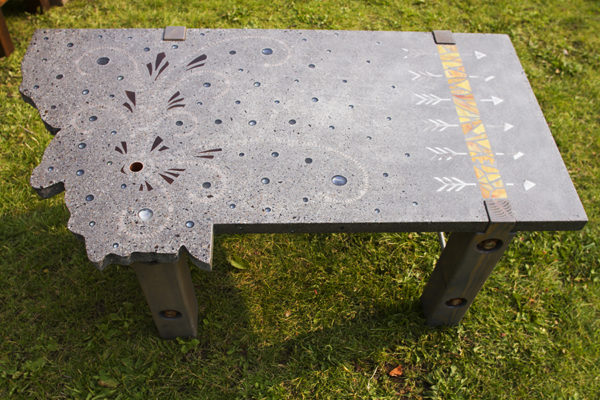
In the midst of undergoing two surgeries, multiple tendon grafts and several years of intensive physical therapy, Osburn realized that he could no longer perform contractual construction work.
“No one was going to pay me to drag my leg around,” he says. “I knew that I was going to have to work smarter, not harder.”
That was when the accidental concrete-and-steel creation resurfaced in his mind and began to blossom into a full-scale idea.
“I’d always liked combining different media into one art form,” Osburn says. “And concrete’s a pretty utilitarian medium, but when I saw how the wire looked inside of it, I realized that I could manipulate concrete to create different designs and expose the aggregate inside.”
In the years prior to his injury, he had built concrete countertops for high-end homes and learned how to mold concrete to fit different functions and aesthetics.
Looking anew at his concrete square, he reflected on how the construction materials had been repurposed into something decorative and symbolic.
“There’s so much excess waste in the world,” Osburn says. “And it’s important to try to give waste another life — upscale it, upcycle it.”
From this one little fragment of industry, from the accidental fusion of utilitarian elements into something new and beautiful, came the idea that would launch Osburn’s one-man business, Veer Off Industrial Designs, or V.O.I.D.
V.O.I.D. specializes in “unique artisan concrete furniture designs” that are “one-of-a-kind, salvaged, upcycled, and handcrafted.” Although Osburn primarily focuses on tabletops, he has branched out into benches, counters, and wall art, all of which are predominantly made from concrete and salvaged materials.
Osburn’s furniture asks its viewers and users to reconsider the possible uses of concrete and to broaden their understanding of its aesthetic.
“You have to look inside the concrete, not just on its surface,” says Osburn, explaining that chunks of quartz crystal and other beautifully colored rocks and minerals are often found in its interior.
Osburn’s furniture-making process begins, of course, with mixing concrete. As the concrete tumbles around in the mixer, getting wet for the first time, Osburn throws in salvaged glass of different shapes, colors, and textures.
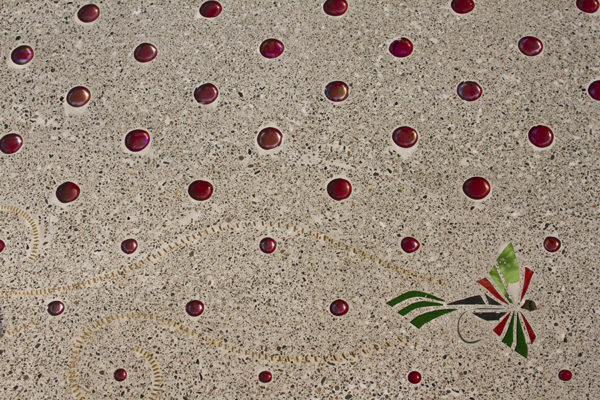
The glass comes from a variety of sources. His friends and family bring him empty wine bottles, jars, and other used glass, which Osburn breaks down into shards. He also obtains and grinds down buckets of broken automobile glass from used car dealers.
Osburn then filters the shards by size, keeping only the smaller pieces, and sorts them by color. Depending on the piece’s specific design, he will choose several corresponding colors of glass to add to the concrete mix.
After the concrete and glass have been sufficiently tumbled, Osburn pours the blend onto a precut melamine form that molds it to the shape that he wants. He lets the concrete dry for several days and then hand-grinds it to the desired texture and gradient, often an extremely lengthy process.
Next, Osburn flips the concrete form over and works out the designs in reverse. If he wants a pattern to extend across a finished table from left to right, he has to design and lay it out from right to left. This requires a fair amount of spatial reasoning, which explains the abundance of mathematical formulas written on the shelves lining Osburn’s workshop.
At this point, Osburn colorizes the concrete by pushing slurries — which are essentially rock-based semiliquid mixtures, each with its own hue — through the voids, or small holes, that form in drier mixes of concrete. (This phenomenon was not behind Osburn’s decision to christen his company V.O.I.D. Instead, the moniker is itself an instance of upcycling: Originally the name of a skateboard art and marketing project that Osburn created with his stepson, he decided to adopt it for his nascent concrete furniture company when the skateboard endeavor fizzled out.)
For surface design, Osburn uses shards of stained glass to painstakingly create mosaics of a range of subjects, including dry flies, sunsets, abstract shapes, mountains, and more. Often, the coloration of the mosaic correlates with those of the slurry and the concrete-and-glass aggregate, so that unifying threads of red or green or blue run throughout the entire piece.
Depending on the design, Osburn incorporates other salvaged materials, such as metal arrows, fishing hooks, stripped electrical wire, used garden art, or copper patina tubing courtesy of his plumber friends. Stripped wire becomes the coiled trail left behind by a butterfly in flight, copper patina forms intentional voids that reveal glimpses of a turquoise interior, and garden art and arrows create intricate symbols.
The entire artistic process, from conceptualizing the design of the piece to hand-carving and staining its wooden legs to finishing its surface with food-grade sealant, takes about a month.

Among the most distinctive indicators of Osburn’s artistic style are what appear to be three-dimensional, glimmering, vibrantly colored bubbles that form different patterns across his furniture, weaving in and out of the mosaics and complementing their pigmentation.
“Without fail, people always touch them because they think they’re raised above the surface,” Osburn says, laughing.
In reality, the glass orbs rest at surface level, but due to their “pearlescent” sheen, they create the illusion of pebbles lined up across the surface.
These characteristic designs did not just come to Osburn in a flash of inspiration, nor was he able to execute them to satisfaction on the first try.
“It was lots and lots of trial and error,” he says. “But I knew there was so much potential.”
It was the craftsman in Osburn that saw the potential in concrete for upscale furniture, but it was the artist in him that visualized the designs it had the potential to showcase.
“There’s a saying that laborers work with their hands, craftsmen work with their hands and brain, and artists work with their hands, brain, and heart,” says Osburn. “And this business has honed all of those skills in me. It’s revitalized the artist in me.”
Osburn has always considered himself to be an artist, and can’t remember a time as a child when he wasn’t carrying around crayons and colored pencils.
“I started out drawing holiday cards for my grandparents,” he says. “In high school, I took a lot of art classes and would finish my work in math class early so I could go to study hall. From there I would get a pass to go the art department.”
An early artistic influence was his father, a real estate agent whom Osburn remembers sitting at a majestic art table in their house in his free time, etching and creating chalk drawings of Montana wildlife. And although Osburn’s work is different from his father’s, both in theme and form, the natural world also figures prominently in his furniture and sparks his creativity. Many of the designs embedded in his tabletops are inspired by animals.
“There are so many spots in nature,” Osburn says. “I’ve always loved the symmetry and patterns of the spots on lizards, salamanders, and snakes, the way the spots will be consolidated on their backs and all of a sudden fan out.”
In Osburn’s tabletops, those spots take form in the luminous glass orbs.
Other designs pay homage to Native American art, color, and culture.
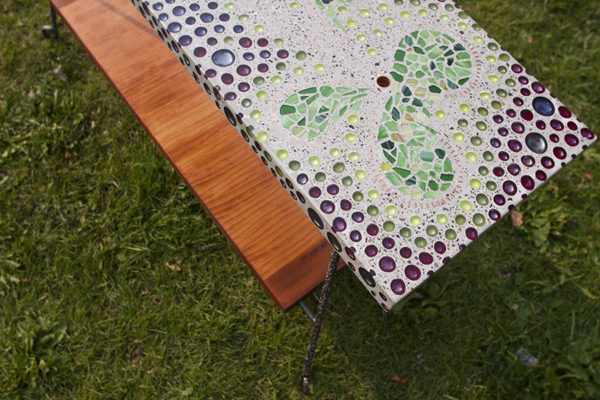
“I have a lot of respect for Native American culture and their use of color,” Osburn says. “It’s at once profound and simplistic. I’ve always thought that a Native American headdress is the best example of what color in the right time at the right place looks like.”
Osburn is currently refinishing a beautiful table inspired by the Sign of the Zia, a symbol of the Zia people that venerates their sacred number, four. The table is a perfect square of pure gray embedded with tiny silver flakes of quartz and ground-down glass. In the middle of the table, a thin metal ring outlines a symmetric circle, within which the rock aggregate is more coarsely textured. Four metal arrows radiate out from each quadrant of the circle, pointing to the four sides of the table.
This table is special to Osburn because of the “ancient meaning behind it.”
This statement, however, holds true for much of Osburn’s work, complicating the seemingly contemporary, minimalist feel of his furniture.
“There’s something that feels really ancient about what I’m doing,” Osburn says. “Humans have always been encompassing things within concrete.”
Some of the very first benches and tables he made looked especially “Viking-ish.” Instead of allowing bolts in the wooden legs to show, Osburn wetted lengths of heavy rope and wrapped them around the legs. The result is furniture that appears to have been crafted before the invention of metal tools.
“In all of my work,” Osburn says, “I start out with simple materials and make a complex mixture out of them. But the finished product is always simple again.”
Looking around Osburn’s workshop, it’s impossible to take everything —or anything — in at first glance. Slightly different viewing positions or angles of light offer completely different perspectives and interpretations of the furniture’s designs.
There’s a table painstakingly carved in the shape of the state of Montana, which features glass orbs of different sizes that mark its different cities. There’s a piece of wall art with tiny apertures in the concrete that, when lit from behind with attached fiber optics, outline the constellation of the Big Dipper. There’s a huckleberry-themed table on tall, thin wire legs, with purple glass orbs patterned across its surface.
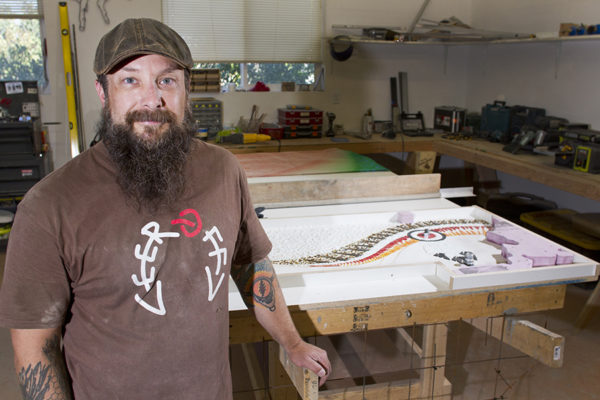
“People don’t even know what’s possible,” Osburn says. “You have to show them first. You have to make it to show them.”
That is exactly what Osburn is doing, and what he aims to keep doing: challenge traditional conceptions of concrete and of furniture, explore the intersections of art and furniture, innovate constantly.
Although he would like to expand his business in the future — take on an apprentice or two and sub out the woodwork to another craftsperson in order to focus more closely on concrete, work on more custom orders, and collaborate with interior designers — he is adamant that the spirit of his work remain unchanged.
“I don’t want to lose my creativity to a utilitarian purpose,” he says. “I don’t want anything to look production line.”
Osburn recently started stamping the bottom of his pieces with his initials, TO, to indicate that each is individually handcrafted.
“You look at that and you know the piece isn’t mass produced,” he says.
Unlike “the symbol TM,” the letters TO don’t “downgrade the piece” — they upgrade it. You might even say that they upcycle it.
Read more of our best long-form journalism in Flathead Living. Pick up the fall edition for free on newsstands across the valley. Or check it out online at flatheadliving.com.
